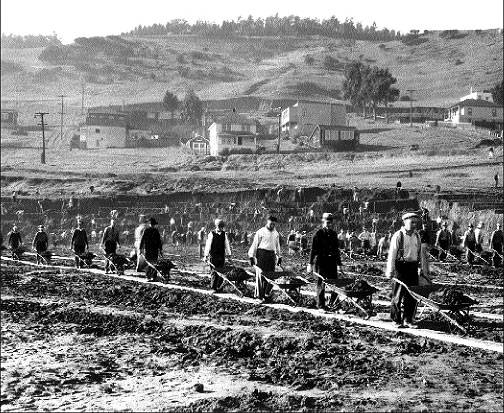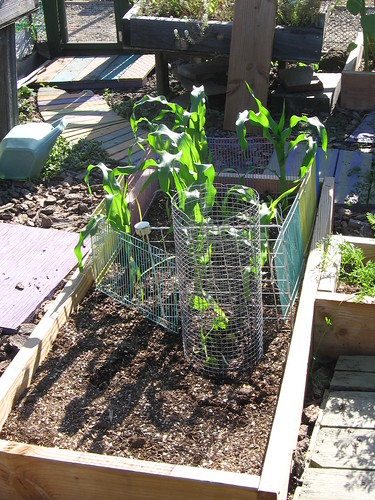 |
| Photo: Jennifer Cowley (The Constituency for a Sustainable Coast) |
Public education is a community garden.
There are many elements that go into the success of a garden. There are different degrees of sun, soil, water, seeds, weeding, and different kinds of gardeners to maintain it.
From far away, our American garden looks both unkempt and unproductive. Wholesalers who weigh our produce at the market look down and shake their heads. Chefs at restaurants say that if we keep at this rate, they won't be able to serve their customers. Then a new crop of architects, after conferring with these chefs and grocery stores, survey our garden woefully, roll up their sleeves and get ready to apply new science and technology and their experience planning buildings to quickly solve the problems of this poorly managed community garden.
The gardeners on the inside have a different view. They see that one side of the garden is thriving. That side has perfect soil and plenty of sun. The seedlings from that side come from an expertly maintained greenhouse. The architects can't see what the gardeners know; this side has a hidden irrigation system that cares for the plants when the gardeners aren't there. The soil is refreshed with compost, lovingly collected and gently spread by the neighbors of that side of the community garden.
The other side of the garden is not so lucky. The soil is hard and barren of nutrition. The trees above give too much shade and pine needles acidify the soil. The seeds must be planted directly, and do not get time in the greenhouse. The hoses are leaky and always breaking.
Gardeners on the inside see and cope with these conditions. The ones on the sunny side come in the morning, and gently trim their plants, shaping them with trellises or tomato cages. They appreciate the superior tools they are given, and how they don't have to hoe every day, or do the grueling tedious work of removing pine needles. The irrigation system lets them wield their spray bottles, polish their fruit, and cultivate a rich and diverse garden of flowers, fruits and vegetables. Yet they appreciate their position, and don't fault the gardeners on the other side for the differences in effects.
The gardeners on the other side have it differently. Some bring a rake from home, and use the handle like a pick ax to loosen up the earth. Others wander around aimlessly picking up pine needles, grumbling that this doesn't feel like the gardening they signed up for. A few dedicated, and often experienced gardeners manage to get flowers to grow out of this awful environment. They have often cleared out the weeds and needles from their area, are doubly proud of their hardy little seeds and their own accomplishments. But most gardeners on this side don't feel that, or only for a season or two. Many realize that they would much rather wield the spray bottle than use the handle of their rake like a hoe and jump into an open spot on the sunny side as soon as they can. Others think they aren't cut out for gardening, and leave the garden altogether, some even become architects. And some give up, lean on their rakes, or sit down and stare off into the distance; ignoring a stray seedling or two, often knowing it won't be enough to take to market.
What do I like about this metaphor?
First, learning as cultivation strikes me as capturing the nature of learning a lot better than the "filling up the head" featured Waiting for Superman, or the "Race" to the Top. It is a more organic process, more obviously complicated.
Second, I think it emphasizes the distortion of the economists such as Eric Hanushek, and policymakers evaluating the entire system as a whole through test scores, comparing to other "community gardens" in other towns (like Singapore, Hong Kong or Finland) just by a crude single metric (perhaps simply weighing the produce?). We have at least two school systems in this country, and the gaps between rich schools and poor schools are stark.
Third, I think it captures the complexity of the situation for the teachers/gardeners. Let me acknowledge a point of the reformers: there are bad teachers. There are teachers who have given up and don't put enough effort into the job. But the next two questions are critical. How many of these are there? In my experience, and that of my friends, siblings and wife, this was small at some of our DC Public Schools. Further, can you be so sure that you can identify the ones who have given up and the ones who are taking a break. I am reminded of John Steinbeck's story about his uncle in his book "A Primer on the 30's" (nice blog post).
 |
| Relief workers in San FranciscoPhoto: Greg Gaar Collection, San Francisco |
Many critics of the shovel leaners have no idea what it is like. Others, like Michelle Rhee, leave after three years, after proclaiming success, despite employing questionable methods. And they are right in principle that an amazing dedicated gardener can have a real impact anywhere. A teacher who is willing to work 70-80 hour weeks and shed blood to feed her little seedlings can, with luck and support, coax a flower from the dust bowl. But this is not a way a way to approach a system or grow a profession. Many things matter to student learning. The student's ability, desire and discipline. The school environment, the class size, the resources available, the course content. External factors wreak havoc on any gardener's well planned regimen: Lead paint, family illness, constant relocation.
This metaphor illustrates to me the approach of Diane Ravitch, the SOS March and the skeptics of top-down, market-based reforms They are on the side of the gardeners, defending their hard-worked, but still weedy patch of earth in front of bulldozers. They agree that the current state of the garden is unacceptable, but they don't think bulldozers and a new set of gardeners will help: the soil is still the same, as is the sun, and the water. But before we have a deeper, more sophisticated discussion about different seeds, soil types, what kind of plants we value, we have to stop the bulldozers and stop attacking the gardeners. What would reform look like, you ask? More compost (resources, aides), more water (interesting content), better tools (higher teacher salaries across the board), and maybe a smaller row to hoe (class size). But this is not the same as saying the garden is perfect as it is.
 |
| Corn in a Community Garden, Photo by Ned Raggett |
I am sure this metaphorical approach doesn't solve anyone's problems, but for me it is a reminder that it is very hard to agree on how to improve education, if we can't agree on what our education system is.
1 comment:
I couldn't agree with your perspective on education as a community garden more. I've been thinking a lot about how a school is an ecosystem, and how in order to make sustainable change, we must cultivate the soil--the foundational aspects that you eloquently outlined in your post, such as resources, content, and working conditions. I've also been thinking about how Permacultural precepts could be usefully applied to public education (I would be honored if you checked out one of my posts on this topic http://bubbler.wordpress.com/2010/12/03/growing-healthy-food-and-children or http://bubbler.wordpress.com/2011/01/08/public-schools-as-ecosystems-part-i). I believe that we must necessarily view education through such a holistic lens if we are going to affect meaningful and lasting change.
Post a Comment